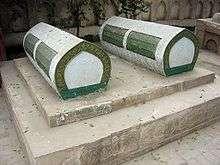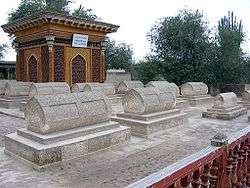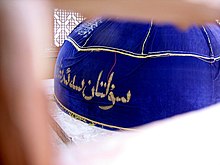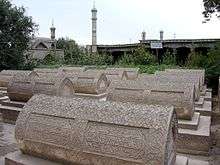Yarkent Khanate
The Yarkent Khanate, also known as the Yarkand Khanate[1] and the Kashghar Khanate,[2] was a state ruled by the Mongol descendants of Chagatai Khan, the majority of whose subjects and conquered population was Turkic in Central Asia. It was founded by Sultan Said Khan in 1514 as a western offshoot of Moghulistan, itself an eastern offshoot of the Chagatai Khanate. It was eventually conquered by the Dzungar Khanate in 1705.
Yarkent Khanate | |||||||||
|---|---|---|---|---|---|---|---|---|---|
| 1514–1705 | |||||||||
 | |||||||||
| Capital | Yarkent | ||||||||
| Common languages | Chagatai language | ||||||||
| Religion | Sunni Islam | ||||||||
| Government | Monarchy | ||||||||
| Khagan, Khan | |||||||||
• 1514–1533 (first) | Sultan Said Khan | ||||||||
• 1695–1705 (last) | Sultan Muhammad Mumin Khan (Akbash Khan) | ||||||||
| History | |||||||||
• Established | 1514 | ||||||||
• Disestablished | 1705 | ||||||||
| Area | |||||||||
| 3,000,000 km2 (1,200,000 sq mi) | |||||||||
| |||||||||
| Today part of | China Kyrgyzstan | ||||||||
Part of a series on the |
|---|
| History of Xinjiang |
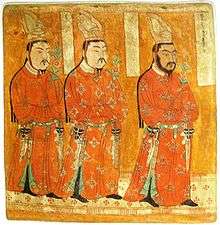 |
|
Medieval and early modern period |
Capital
Yarkent served as the capital for the Khanate, and was also known as the Yarkent State (Mamlakati Yarkand), from the establishment of the Yarkent Khanate to its fall (1514–1705). The previous Dughlat state of Mirza Abu Bakr Dughlat (1465–1514) of Kashgaria also used Yarkent as the capital of state.
History
The Khanate was predominantly Uyghur/Turki; some of its most populated cities were Hotan, Yarkent, Kashgar, Yangihissar, Aksu, Uchturpan, Kucha, Karashar, Turpan and Kumul. It enjoyed continued dominance in the region for about 200 years until it was conquered by the Dzungar Khan, Tsewang Rabtan in 1705.
In the first half of the 14th century the Chagatai Khanate had collapsed; on the western part of the collapsed Chagatai Khanate, the Empire of Timur emerged in 1370, and became the dominant power in the region until its conquest in 1508 by the Shaybanids. Its eastern part became Moghulistan, which was created by Tughluk Timur Khan in 1347 with the capital centered in Almalik, around the Ili River Valley. It comprised all the settled lands of Eastern Kashgaria, as well as regions of Turpan and Kumul which were known at the time as Uyghurstan, according to Balkh and Indian sources of the 16th and 17th centuries. The reigning dynasty of the Yarkent Khanate originated from this state, which existed for more than a century.
In 1509 the Dughlats, vassal rulers of the Tarim basin, rebelled against the Moghulistan Khanate and broke away. Five years later Sultan Said Khan, a brother of the Khan of Moghulistan in Turfan, conquered the Dughlats but established his own Yarkent khanate instead.[3][2]
This put an end to the dominance in the cities of Kashgaria of the Dughlat emirs, who had controlled them since 1220, when most of Kashgaria had been granted to the Dughlat by Chagatai Khan himself. The conquest of the Dughlats allowed the Yarkent state to become the foremost power in the region.
The reign of Sultan Said Khan was heavily influenced by the khojas.[4] Said Khan also had a close relationship with Babur, his cousin and founder of the Mughal Empire across the Himalayas and Karakoram Range from the Yashkent Khanate.[2]
Said Khan's reign included a "holy war" raid into Badakhshan in 1529 and looting expeditions into Ladakh and Kashmir in 1532.[5] Sultan Said Khan purportedly died in 1533 at Daulat Beg Oldi of a high-altitude pulmonary edema while returning to Yarkent from an expedition into Ladakh and Kashmir.[5][6][7][8]
Sultan Said Khan was succeeded by Abdurashid Khan (1533–1565), who began his reign by executing a member of the Dughlat family. Abdurrashid Khan also fought for control of (western) Moghulistan against the Kirghiz and the Kazakhs, but (western) Moghulistan was ultimately lost; thereafter the Moghuls were largely restricted to possession of the Tarim Basin.[9]
Meanwhile, the Yarkent Khanate was conquered by the Buddhist Dzungar Khanate in the Dzungar conquest of Altishahr[lower-alpha 1] from 1678 to 1705.[10]
List of rulers
Culture
The collection of Uyghur Twelve Muqam
Gallery
Notes
- Altishahr historically was a union of 6 cities: four cities in Western Kashgaria-Hotan, Yarkand, Kashgar, Yengihisar and two cities in Eastern Kashgaria: Uchturpan and Aksu. Cities that were located east of Aksu, such as Kucha, Karashar, Turpan and Kumul, were not included in Altishahr. This division first appeared in the 15th century during the struggle between Mirza Abu Bakr Dughlat and the Moghul Khans, when Abu Bakr managed to separate Altishahr into an independent state called Mamlakati Yarkand with its capital in Yarkand. The Mughal khans then managed to establish control of the most of former Uyghuria (856–1389), mediaval state of Buddhist/ Nestorian/ Manichaenian Kingdom, that included Kucha, Karashar, Turpan, Kumul and Beshbaliq. That state submitted to Chengiz Khan in 1211 under Idikut Baurchuk Art Tekin and joined Mongol Empire as its 5th Ulus and this way retained independence till 1389, when was conquered by Khizr Khoja ( son of Tughluk Timur Khan), who spread Islam among population of Uyghuria. In 1462 Moghul Khan Dust Muhammad managed to wrest Aksu from Mirza Abu Bakr, later Yunus Khan (1462–1487) spread influence of Moghul Khans till Turpan and Kumul and this independent state became known as Uyghurstan. In 1514 Sultan Said Khan put an end to this division and united all territory south of Tengri tagh from Kashgar to Kumul in one centralized state, known in different sources as Kashgar and Uyghurstan (Mahmud ibn Wali, Balkh, 1640), Saidiyya, Kashgar Khanate or more properly Yarkand Khanate, that existed under dominance of Yarkand Khans till 1706 and under dominance of Khojas till 1759 when it was conquered by Qing China.
References
- Buckley, Chris; Myers, Steven Lee (18 January 2020). "Battered but Resilient After China's Crackdown". New York Times. Retrieved 13 August 2020.
- Bano, Majida (2002). "Mughal relations with the Kashghar Khanate". Proceedings of the Indian History Congress: 1116–1119. JSTOR 44158181.
The Kashghar Khanate (whose capital was actually Yarkand) was established when Sa'id Khan (d.1533), a Mongol Muslim ('Moghul') prince invaded the Tarim basin and overthrew the local ruler Mirza Abu Bakr in 1514. [...] Babur, the founder of the Mughal Empire, and Sa'id Khan were cousins, and the relationship was recognised in Babu'r memories. In a sense the Khanate and the Mughal Empire were built together, though there could be no military cooperation between the two, given the heights of the Hamalayas and the Karakoram Range that separated the two states.
- Grousset 1970, p. 497.
- Grousset, p. 500
- Baumer, Christoph (2018). History of Central Asia, The: 4-volume set. Bloomsbury Publishing. ISBN 1838608672.
- Albert von Le Coq (14 December 2018). Buried Treasures of Chinese Turkestan: An Account of the Activities and Adventures of the Second and Third German Turfan Expeditions. Taylor & Francis. p. 292. ISBN 978-0-429-87141-2.
Daulat Bak Oldi (the royal prince died here), close to the Karakorum pass, is so called because the Sultan Said Khan of Kashgar, on his return from a successful campaign against West Tibet, died here from mountain sickness (Plate 50)
- Howard, Neil; Howard, Kath (2014), "Historic Ruins in the Gya Valley, Eastern Ladakh, and a Consideration of Their Relationship to the History of Ladakh and Maryul", in Lo Bue, Erberto; Bray, John (eds.), Art and Architecture in Ladakh: Cross-cultural Transmissions in the Himalayas and Karakoram, pp. 68–99, ISBN 9789004271807: "When his Khan decided to return home because of ill health, leaving Mirza Haidar to destroy "the idol temple of Ursang (i.e. Lhasa)", he "set out from Maryul in Tibet, for Yarkand". He "crossed the pass of Sakri", which must be that above Sakti (not the Kardung pass as Elias and Ross suggest), descended to Nubra and died at a camping place named Daulat Beg Uldi which is two-and-a-half hours below the Karakoram Pass."
- Bhattacharji, Romesh (7 June 2012). Ladakh - Changing, yet Unchanged. Rupa Publications Pvt Ltd. ISBN 978-8129117618.
Some 400 years earlier, in ad 1527, a Yarkandi invader, Sultan Saiad Khan Ghazi (also known as Daulat Beg) of Yarkand, briefly conquered Kashmir after fighting a battle along this pass. He died in 1531 at Daulat Beg Oldi (meaning, where Daulat Beg died) at the foot of the Karakoram pass, after he was returning from an unsuccessful attempt to invade Tibet.
- Grousset, pp. 499–500
- Adle, Chahryar (2003), History of Civilizations of Central Asia 5, p. 193
Bibliography
- Saray Mehmet, Doğu Türkistan Tarihi (Başlangıçtan 1878’e kadar), Bayrak Matbaacılık, İstanbul-1997
- Kutlukov M, About foundation of Yarkent Khanate (1465-1759) , Pan publishing house, Almata,1990
- Grousset, Rene (1970), Empire of the Steppes, Rutgers University Press, ISBN 0813513049

